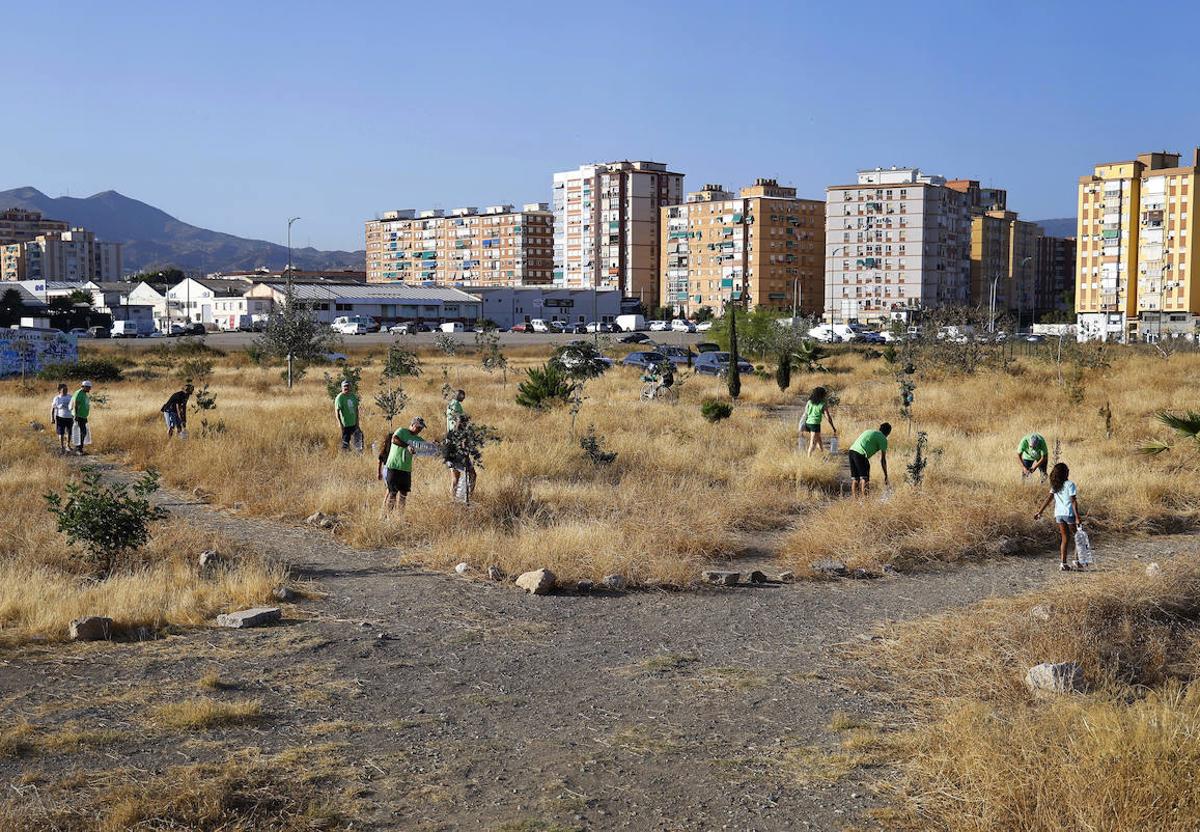The urban forest that is slowly taking shape in the heart of Malaga
A group of volunteers have been planting trees on the site for several years with the hope that, once established, it will be a refuge from the heat as the temperature here could be up to 6C cooler than the concrete and asphalt jungle surrounding it
The urban forest in Malaga city (Bosque Urbano de Málaga - BUM) is becoming a reality through positive action and by good deeds from locals who have already planted some 300 trees and who organise watering days every week so that everything planted takes root, prospers and is eventually able to provide shade. That is when their dream will become a reality because then this place, now still somewhat desolate, will become a climate refuge, a place that provides 'thermal relief' from the heat. This expression is heard more and more frequently because global warming makes the existence of these oases in the cities increasingly necessary so that the local population can take refuge from extreme climate events such as excessive heatwaves. On this former Repsol site the locals planting the trees and looking after them assure that it will be 5 or 6C cooler than standing next to the blocks of flats in the area or on the asphalt-covered streets.

SUR showed up for one of these plant-watering days. On a hot August afternoon a dozen volunteers of all ages gathered with their containers full of water taken from a private well. Mains water from municipal supplies is not allowed to be used for this purpose under the regulations set down by the regional and city authorities in times of drought, which multiplies the effort needed to care for the plants. The volunteers have to be - and they are - very assiduous with the watering, organising it by zones so that no tree is forgotten. From the small hill overlooking the piece of land you can see how these individuals dressed in green T-shirts spread out over the plot, stopping at every cutting, every shoot, every small tree - although some are now not so small as the planting began seven years ago, so there are sizeable specimens of that age.



The emotional ties between each plant and the volunteers are immediately evident. Many of them have planted trees of their own and feel responsible for their continued growth. Juan Espejo says he is particularly fond of his holm oak, Libertad, "a tree", he says, "that means the whole forest". Pepe Aguilar says he has planted around eight to ten, mainly poplars and pines. Pilar Camero has four - one named after her granddaughter Daniela - including a carob tree and a 'penca' (drought-resistant plant). The latter is a species native to Mexico, but which can now be considered native to Spain since it has been here for 500 years.
"We are speeding up the pace of nature," says one of the volunteers
The person to tell us about the penca is Francisco Javier Sarmiento, a technical engineer in industrial electronics but with a knowledge of, and commitment to, the development of the Malaga urban forest that anyone could easily take him for a botanist or a forestry specialist. Sarmiento explains that this space would go back to nature eventually and so all that the local volunteers are doing is making the process go faster: "We are accelerating the pace of nature". He is careful to insist that they are only repopulating the land with species from the Mediterranean area, such as pine trees, olive trees, poplars, cork oaks, carob trees, rosemary, broom, thyme, mastic trees. No invasive species here. Sarmiento also points out that although, in Malaga and along the Costa del Sol we are used to seeing palm trees everywhere, they are actually exotic trees and are not native to this part of the world. In fact, he warns that this is one of the causes of the extinction of some native species that were displaced by foreign ones.
A forest that will stand alone
One of the positive consequences of planting trees native to the area is that, as Sarmiento explains, once they "know how to walk", once they have managed to take root in the soil and get a foothold, they will not need anything else, they will develop and grow on their own. That is why the group insists that what they want for this area is not a park, but a real forest, something that results in lower maintenance costs.
However, before it can be fully enjoyed, much remains to be done. To begin with, they must continue with the planting. Specimens sometimes come from nurseries. Other times the neighbours themselves sow seeds in pots in their own homes and then transplant the results to this plot of land. They also work a lot with the trial-and-error system. Fortunately their experiments are getting better and better, like the one that consisted of planting a branch of a poplar tree that has taken root and now another healthy and vigorous shoot is growing from that branch.
So once the summer is over, efforts will have to be redoubled. Planting in autumn means using less water and a greater chance of success: the 300 trees need 3,000 or 3,500 litres a month in summer, compared to 1,000 litres in the winter months. So, speaking of water, Sarmiento mentions that there is an aquifer in the subsoil (porous rock saturated with groundwater). In fact it was this feature of the land and its proximity to the port that caused Repsol to choose this location. The groundwater just needs decontaminating and it can then supply the trees. In any case, says Sarmiento, as the land is planted with species typical of the Mediterranean climate, their water consumption is limited - unlike that of a garden or a park - because they have adapted to the fact that so little water falls from the sky around here.
The aim of the volunteers is to make the urban forest more visible. Now, from the cycle lane that runs parallel to the site dotted with plants, their work is barely visible, so they are trying to get the trees to grow next to the fence on Avenida de Juan XXIII.
No to investment speculation
These Malaga residents are opposed to the urban development of the land. They fear it would do nothing to alleviate the city's need for affordable housing. They suspect it is just a speculative financial operation: "The people here won't be able to buy any of the houses that are built," they say. So they argue: "If the mayor wants to go down in history, if he wants to make the city less centralised, he should build a 'Central Park' here. In other cities, green spaces also become tourist attractions".
"If the mayor wants to go down in history, if he wants to make the city less centralised, let him create a 'Central Park' here. In other cities, green spaces also become tourist attractions"
Ismael Romero, a 19-year-old gardening and floristry student, also brings up the problem that the neighbourhoods surrounding these plots, which are the most populated in Malaga, have hardly any green spaces. He also mentions the fact that the work of the volunteers is not limited to planting and watering: they clean up the site, use stones to create paths and turn it into a pleasant space that, for the time being, is mainly enjoyed by dogs and their owners. However, this climate refuge in its infancy sometimes also becomes an outdoor home for those who cannot find a housing solution in the asphalt jungle.

